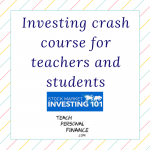It can be hard to know what exactly needs to be taught in a Personal Finance class – especially if you are teaching for the first time. In fact, educators around the country have been trying to answer that question for the last 40 years, which has led to the development of Financial Literacy Standards.
Financial Literacy Course Unit Lists
We have a list of links to all of the currently-published personal finance standards below, but most states broadly follow the same structure that is recommended at the National level. This groups the topics that should be included in a financial literacy course into 5 broad topics:
Earning Income/Employment
These are topics about building a career – a hot topic in every set of standards. This comes down to helping students understand the “nuts and bolts” of making money and earning a paycheck – including what a paycheck looks like. There is also a lot of points talking about other compensation that needs to be considered when comparing jobs, such as:
- Working conditions, including flexible hours or work-from-home
- Insurance benefits
- Potential career growth
- On-the-job training
There is also usually a section on covering income taxes (and other taxes) folded into this unit, along with career planning and post-secondary education and training options.
Spending
The “Spending” units cover everything about what it means to spend money. When one thinks about “Personal Finance”, this is usually the first thing that comes to mind, since it includes budgeting, spending plans, and how to divvy up a paycheck.
Most first-time personal finance teachers spend the most class time in this section, because it covers the topics that are the most familiar after being an adult for a while. However, veteran teachers find that they allocate more time to the other units the more times they teach the class, since it covers the easier-to-miss concepts that can really make a difference. This topic is best served with a class budgeting game to really hammer home budgeting concepts to students.
Saving and Investing
This unit is all about compound interest and growing money over time – and what taxes come with it. We find that teachers are eager to dive in to the first topics that usually get covered (savings accounts, learning about compound interest, the idea behind “Risk vs Reward”), but many times their own lack of personal investing knowledge can make other topics in this unit seem a little harder to handle. We recommend taking a free investing course to build up your own confidence, then utilize a stock game in classes as the perfect supplement.
Credit and Debt
“Credit and Debt” is another big one that everyone “wishes they learned about in high school”. This covers the usual suspects, like credit cards, car loans, and mortgages, and does deep dives about what it means to build a credit score and read a credit report. While “Saving and Investing” really covers how to build wealth, “Credit and Debt” is more about how not to lose it.
Managing Risk
“Risk Management” is really code for “Insurance” for personal finance. This can be the most boring, and most complicated to teach, unit in a personal finance course, because there is so much nuance to what exactly is covered in different types of insurance policies. Veteran teachers usually spend a bit more time on this topic, particularly health insurance lessons.
List of Financial Literacy Standards
Below are links to each of the published sets of Personal Finance standards (that we have found so far!)
National
- Combined National Standards for Personal Finance Education (Jump$tart and Council on Economic Education)
State
- Alabama
- Alaska
- Arizona
- Arkansas – Economics and Personal Finance
- Arkansas – Personal Finance
- Colorado
- Connecticut – Follows National standards
- Delaware
- Florida
- Georgia
- Hawaii
- Idaho
- Illinois – Consumer Education
- Illinois – Social Studies with FinLit
- Indiana
- Iowa
- Kentucky
- Louisiana
- Maine
- Maryland
- Michigan
- Minnesota
- Mississippi
- Missouri
- Montana
- Nebraska
- Nevada
- New Hampshire
- New Jersey
- New Mexico
- New York
- North Carolina
- North Dakota
- Ohio
- Oklahoma
- Oregon
- Pennsylvania
- Rhode Island
- South Dakota
- Texas – Money Matters
- Texas – Personal Finance and Economics
- Tennessee
- Utah
- Vermont
- Virginia
- Washington
- Wisconsin
- Wyoming

 The Investing101 Course
The Investing101 Course What Is Taught In A High School Personal Finance Class?
What Is Taught In A High School Personal Finance Class? Teach Taxes to Your Students
Teach Taxes to Your Students